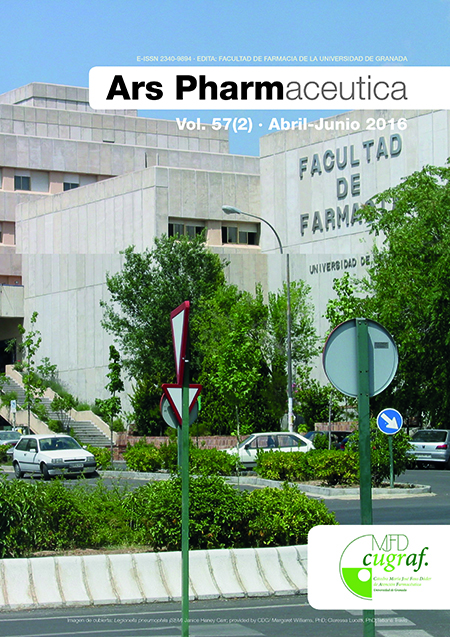Synthesis and cytotoxic activity of conjugates of the uridine with triterpenes on breast cancer cells
DOI:
https://doi.org/10.30827/ars.v57i2.4962Keywords:
breast cancer, cytotoxic activity, nucleosides, triterpenes, uridine derivativesAbstract
Aims: Synthesize of uridine acetonide conjugates with triterpenoids (cholesterol and 3β-5α,8α-endoperoxide-cholest-6-en-3-ol) and succinic acid as linking.
Methods: The acetonide derivative of uridine was prepared with acid catalysis in acetone. Sterols succinates were prepared with succinic anhydride and nucleophilic catalyst 4-N,N-dimethylamino-pyridine (DMAP). The conjugates were synthesized by Steglich method with N,N’-dicyclohexylcarbodiimide (DCC) Coupling agent and DMAP. The compounds were characterized by NMR spectroscopy (1H NMR, 13C NMR), and mass spectrometry. The derivatives were assessed in Chinese Hamster Ovary (CHO) and breast cancer (MCF-7) cell lines.
Results: The conjugates of uridine acetonide with two triterpenes were obtained with yields higher than 80%. The conjugates prepared don’t showed significant inhibition of cell viability on MCF-7 and CHO cell lines, furthermore these substances did not show a relationship dose-response.
Conclusions: The esterification method with coupling agents allowed obtained uridine conjugates with triterpenoids. However the uridine derivatives don’t showed significant cytotoxic activity (p<0,05) against cell lines evaluated.
Downloads
Downloads
Published
How to Cite
Issue
Section
License
The articles, which are published in this journal, are subject to the following terms in relation to the rights of patrimonial or exploitation:
- The authors will keep their copyright and guarantee to the journal the right of first publication of their work, which will be distributed with a Creative Commons BY-NC-SA 4.0 license that allows third parties to reuse the work whenever its author, quote the original source and do not make commercial use of it.
b. The authors may adopt other non-exclusive licensing agreements for the distribution of the published version of the work (e.g., deposit it in an institutional telematic file or publish it in a monographic volume) provided that the original source of its publication is indicated.
c. Authors are allowed and advised to disseminate their work through the Internet (e.g. in institutional repositories or on their website) before and during the submission process, which can produce interesting exchanges and increase citations of the published work. (See The effect of open access).























